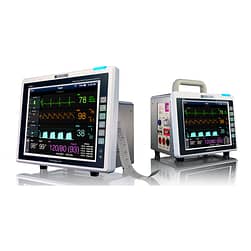
Curious to learn more about low flow anesthesia?
Why does Dr. Brock use this technique for all her patients? What are the benefits of low flow anesthesia?
Dr. Brock shares everything you need to know about low flow anesthesia, from the benefits to the protocol to use, to an analogy for a better understanding and valuable tips.
The closed circuit anesthesia technique involves delivering inhalant anesthesia using only the patient’s metabolic oxygen requirement as your oxygen flow rates such that you can completely close the pop-off valve of your scavenger apparatus. We’re not going there today. Instead, let’s discuss the less drastic and less scary “low-er flow” anesthesia which is simply the delivery of inhalant anesthetic gas to the patient using lower-than-usual oxygen flow rates. However, though the steps involved are simple, the effects of using lower less traditional flow rates need to be understood in order for the anesthetist to be comfortable using the technique.
Why do I use low flow anesthesia techniques for all my patients?
Because:
- the reduced oxygen flow rate blunts the severity of hypothermia and reduces patient moisture loss.
- there is a lower cost of inhalant anesthesia consumables because of the reduced usage of oxygen and the inhalant anesthetic liquid.
How to apply low oxygen flow anesthesia delivery techniques:
- I start with an initial flow rate of 200 mL/kg/minute oxygen. Some flow meters have a maximum setting of 4 liters. This may be below your calculated flow rate for very large dogs in which case, simply set the flow meter to its maximum flow setting.
- After intubation and cuff inflation, I set the vaporizer to dial somewhere between 0.5 and 3% isoflurane-based end-tidal CO2 values and the physical signs of anesthetic depth.
- I use these same indicators to raise or lower my vaporizer dial setting over the next 10 minutes as my patient transitions from injectable induction to inhalant maintenance.
- After 10 minutes (at which point I have flushed out all the room air in the anesthetic machine and the patient’s lungs and replaced it with oxygen) I reduced the oxygen flow rate to 500 mL/minute total flow (not /kg!). I never set the oxygen flow meter lower than 500 mL total flow because lower settings make the vaporizer output less reliable. At this low flow, I am still providing more oxygen than the patient requires. This is why, even at this low flow rate, I can’t completely close the pop-off valve: there is excess delivered oxygen that must escape in order to avoid a buildup of pressure in the breathing system.
- As I lower the oxygen flow rate, if I want the depth of anesthesia to remain the same, I increase the vaporizer dial setting by 0.5% isoflurane. If, on the other hand, I’d like to lighten the plane of anesthesia, I simply leave the vaporizer setting unchanged after reducing the oxygen flow rate.
- When I detect an unwanted change in the depth of anesthesia, I adjust the vaporizer dial setting up or down. I monitor for changes in anesthetic depth carefully and continuously so as not to get caught off guard by a patient that becomes too lightly anesthetized. This vigilance enhances anesthesia safety in my opinion.
- If the patient reacts suddenly and unexpectedly to a painful manipulation, I administer 0.5 mg/kg ketamine IV to get the pain quickly under control and prevent patient movement.
- If I need to deepen the plane of inhalant anesthesia quickly and my patient is not at risk of actually moving, I increase the vaporizer dial setting by 0.5% or 1% and also increase the oxygen flow rate back to the original 200 mL/kg/minute until I see the beginning of the desired change in depth at which point I reduce the oxygen flow rate back down again. I may decide to leave the vaporizer to dial at this new setting, raise it further or reduce it depending on the patient’s response over time.
- At the end of anesthesia, when I want my patient to wake up, I raise the oxygen flow rate as I turn the vaporizer off.
NOTE: All patients are receiving isoflurane and oxygen without nitrous oxide through circle breathing systems, either adult or pediatric size depending on the patient’s weight:
How the change in oxygen flow rates affects the delivered amount of inhalant anesthetic?
Try this analogy:
- Think of the oxygen molecules as cargo vans that are sitting, waiting in the parking lot (the oxygen tank). The vaporizer is the isoflurane storage warehouse, and the breathing hoses are the highway.
- When the flow meter is turned on, each oxygen molecule travels from the parking lot to the warehouse and picks up whatever amount of inhalant cargo that you have chosen with your vaporizer setting ie 1%, 2% etc.
- The oxygen then leaves the warehouse and travels onto the highway to the patient where it makes its inhalant delivery.
- After the delivery, the cargo van oxygen leaves the patient but does not return to the warehouse. Rather, it travels round and round on the highway (breathing hoses) until it takes the exit ramp to leave via the scavenge/pop-off apparatus.
- As you increase or decrease the number of cargo vans (oxygen flow), you increase or decrease the TOTAL amount of anesthetic being delivered to the patient. If you don’t make any adjustments to the vaporizer dial setting as you reduce the oxygen flow rate say from 2 liters to 1 liter/minute, you don’t change the amount of cargo in each van, but you do reduce the total number of vans and thus the TOTAL AMOUNT OF CARGO.
- Over the course of a procedure, the amount of cargo that each van carries doesn’t change unless you change the vaporizer dial setting. But the total amount of delivered cargo goes up or down with the changes in the number of vans making deliveries.
To my knowledge, most clinicians do not use low-flow anesthesia. Some of the reasons for this are associated with the mistaken belief that reduced oxygen flow rates are associated with increased anesthesia risk. In fact, there are no data to support this association. And as I have proposed in past blogs, anesthesia risk/safety is more related to the skill of the anesthetist than oxygen flow rates or even drug selection.
So, why bother?
- In my opinion, not using lower oxygen flow rates means missing an opportunity to reduce some of the costs associated with anesthesia consumables as well as causing unnecessary heat and moisture loss from the patient. More importantly, being able to skillfully manipulate both oxygen flow rates AND vaporizer dial settings allows the anesthetist better ability to control anesthetic depth.
- Anesthetists who understand the dynamics of oxygen flow rates gradually drop the tendency to worship the vaporizer dial setting and spend more time assessing anesthetic depth by observing the patient. This is an important skill since a patient’s inhalant anesthetic requirements are influenced by many many factors such as the patient’s age, health status, body temperature as well as the type and amount of premedication induction and constant rate infusion drugs that are administered.
Few hints on how to get started with low flow anesthesia technique:
- Choose healthy patients undergoing elective procedures.
- Do everything you normally do at the beginning in terms of oxygen and vaporizer settings.
- 15 minutes after you have turned the oxygen on, reduce the oxygen flow rates by some amount that you are comfortable with, remembering to adjust the vaporizer setting upwards unless you actually intend to lighten the plane of anesthesia (unlikely at the beginning of a case).
- Then just watch what happens. Monitor anesthetic depth carefully. If you have capnography monitoring capabilities, you will find that the changes in the end-tidal carbon dioxide readings are excellent predictors of changes in anesthetic depth.
Follow my steps above when it comes to navigating unwanted changes in anesthetic depth and also as you prepare to wake your patient up.










